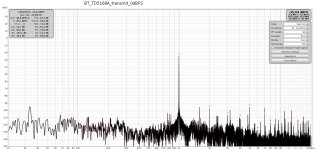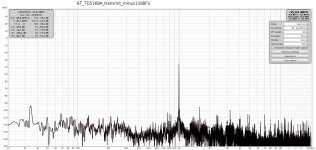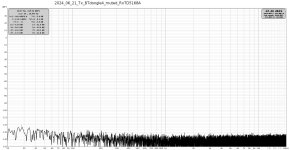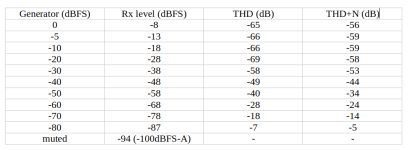The manufacturer is Zuhai Jie Li I believe.
They can be programmed if you have the ability and setup, from what I have seen.
They can be programmed if you have the ability and setup, from what I have seen.
Hi, I've got the same product and would be interested in that IC also. I found other 3 manufacturer's references...
Please let me know if you find more. Cheers. Andreas.


Please let me know if you find more. Cheers. Andreas.
For those who would like to add Bluetooth ability to your hifi, here is my experience. I have great success with this MH-M28 board:
https://www.aliexpress.us/item/3256...7c779d&afSmartRedirect=y&gatewayAdapt=glo2usa
Powered with a 5V smps. I use an old Samsung screen psu followed with a dc-dc buck converter from 19V to 5V and then a simple CLC filter. This board has a 3.5mm audio out socket. Connected to my Zen Mod Iron Pre preamp it is dead quiet and perfect gain for my system. Sound quality is actually very good for Bluetooth streaming from Spotify on a cellphone.
I first tried a few MH-M18 boards but they all were very noisy and low gain.

https://www.aliexpress.us/item/3256...7c779d&afSmartRedirect=y&gatewayAdapt=glo2usa
Powered with a 5V smps. I use an old Samsung screen psu followed with a dc-dc buck converter from 19V to 5V and then a simple CLC filter. This board has a 3.5mm audio out socket. Connected to my Zen Mod Iron Pre preamp it is dead quiet and perfect gain for my system. Sound quality is actually very good for Bluetooth streaming from Spotify on a cellphone.
I first tried a few MH-M18 boards but they all were very noisy and low gain.
At the moment I have exact the same board that I purchased on-line several days ago.
I will test it within the next days.
Interesting: If you look at actual images on amazon/ebay you will find different chips from JL, for instance AC1818AP
there is very little hope to find detailed information about these chips from outside china.
I will test it within the next days.
Interesting: If you look at actual images on amazon/ebay you will find different chips from JL, for instance AC1818AP
there is very little hope to find detailed information about these chips from outside china.
Meanwhile I can measure the BT stream using REW.
With 1kHz 0dBFS transmit level I see 253mV analogue output with -66dB THD.
Reducing output to -10dBFS yields -71dB THD.
Not tooo bad - but nothing to call home about.
To be fair, this is overall performance, including a BT-5.0 USB transmitter dongle of unknown quality.
Perhaps with some other transmitter higher output level with less THD is possible
This TD5168A module was powered using one 18650 Li-Ion battery draining about 15mAdc.
With 1kHz 0dBFS transmit level I see 253mV analogue output with -66dB THD.
Reducing output to -10dBFS yields -71dB THD.
Not tooo bad - but nothing to call home about.
To be fair, this is overall performance, including a BT-5.0 USB transmitter dongle of unknown quality.
Perhaps with some other transmitter higher output level with less THD is possible
This TD5168A module was powered using one 18650 Li-Ion battery draining about 15mAdc.
Attachments
Last edited:
I don’t want to mislead anyone here. The link to the MH-M28 board available at AliExpress in my post above was just an example. I sourced my board from a local supplier and the manufacturer is listed as SUNLEPHANT. My board has the following JL chip: AC21BP0C464-25C4Interesting: If you look at actual images on amazon/ebay you will find different chips from JL, for instance AC1818AP
Although the SQ is quite amazing, this board does color the sound compared to my DAC. The bass is boosted a lot. So much so that I switch off my sub when streaming via Bluetooth. Another nice feature of this board is that you don’t have an annoyingly load Chinese lady voice - only a gentle chime when powering on and connecting from a BT device.
Meanwhile I did some investigations and improvements.
The residual noise pattern with generator muted reminded me of the bluetooth-specific noise
originating from pulsating power consumption - together with ground loops.
So I added a low polymere low-ESR electrolytic directly at the battery terminals of the pcb
and reworked my false ground wiring:
Battery minus is connected with its own wire directly with PCB
so gnd audio return wire does not conduct any supply current.
As can be seen this did the trick
The residual noise pattern with generator muted reminded me of the bluetooth-specific noise
originating from pulsating power consumption - together with ground loops.
So I added a low polymere low-ESR electrolytic directly at the battery terminals of the pcb
and reworked my false ground wiring:
Battery minus is connected with its own wire directly with PCB
so gnd audio return wire does not conduct any supply current.
As can be seen this did the trick
Attachments
Last edited:
I had some trouble to setup the measurement with my linux laptop.
Finally I concluded that my linux cannot handle the bluetooth sound output simultaneously with USB soundcard input.
At the end I used 2 seperate linux laptops which worked fine.
With a generator level set to 0dBS the BT-receiver puts out 0.9Vrms at each output,
I think there is not much more to be expected from a single Li-Ion supply.
So I stepped generator level over the entire range and the results can be seen in this table
The S/N ratio is better than 80dB - not bad at all -
while best THD comes close to 70dB, THD+N close to 60dB.
This is not what we call hi-end -
but good enough for many daily applications.
Finally I concluded that my linux cannot handle the bluetooth sound output simultaneously with USB soundcard input.
At the end I used 2 seperate linux laptops which worked fine.
With a generator level set to 0dBS the BT-receiver puts out 0.9Vrms at each output,
I think there is not much more to be expected from a single Li-Ion supply.
So I stepped generator level over the entire range and the results can be seen in this table
The S/N ratio is better than 80dB - not bad at all -
while best THD comes close to 70dB, THD+N close to 60dB.
This is not what we call hi-end -
but good enough for many daily applications.
Attachments
- Home
- Source & Line
- Digital Source
- Bluetooth audio module



